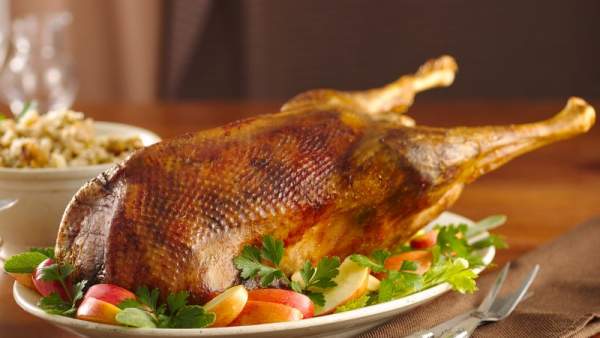Christmas is a multi-sensory experience: Christmas lights blinking, bells jingling, the smell of clove and evergreen in the air ... mmmmm! And then there are the foods that we associate with the holiday season: cinnamon and peppermint, chocolate and eggnog, savory roasts with a side of pudding ... oh, my! Probably doesn't matter what country or culture you come from: food is an indispensible part of the season.
Attached is my list of foods that are traditionally and/or sentimentally associated with the holidays. Either they feature prominantly in Christmas literature, rate a mention in Christmas carols, or are indelibly linked with the season. I freely admit that this list is Eurocentric, but since Europe gave us St. Nikolas and Christmas trees, I figure that's only fair. Enjoy the list ... just don't drool on your keyboard as you read!
- Roast goose (alt: pheasant, duck). What's the first thing Scrooge does after waking up on Christmas morning? That's right ... he sends an urchin off to buy him the biggest goose in the window! Roast goose was the traditional Christmas dish back in Dickens' day, and - by the way - also plays a feature role in the Sherlock Holmes holiday tale, The Blue Carbuncle.
- Oysters (alt: oyster stew). Many 18th and 19th century accounts of Christmas festivities make special mention of oysters and oyster stew. Why? Back in the day Catholics considered it bad form to eat meat the day before religious festivals like Christmas, so seafood was the only alternative, and oysters were one of the few types of seafood still plentiful (and affordable) in winter.
- Mincemeat pie. According to the food historians, mincemeat pie dates back to Medieval times. At that time, this recipe did, indeed, include meat. It also often contained dried fruits, sugar, and spices. The distinction between mincemeat and mince was drawn in the mid-nineteenth century when meat began disappearing from the recipe, leaving the fruit, nut, sugar, spice, and suet product we know today. Late 19th century cookbooks contain several recipes for both mincemeat and mince, some containing meat, others not.
- Sweetmeats/nuts (alt: roasted chestnuts). The term "sweetmeats" hints at the tradition behind that bowl of mixed, shelled nuts your aunt used to leave out on the mantle every December. For thousands of years, nuts have been considered an exotic delicacy. Kind of makes you appreciate why people made a big deal out of their nutcrackers.
- Stollen/bishop's bread/fruitcake. Possibly the most reviled holiday treat, which is really unfair. Believe it or not, back in the 18th century fruitcakes were so associated with wealth and decadence that they were briefly outlawed as an example of "sinful excess". Sure, everyone's probably had at least one bad experience with fruitcake, but don't knock it until you've tried the genuine article, homemade from an old family recipe, stuffed with lightly preserved fruits, sweetmeats, honey, and a generous portion of brandy ... yum!
- Buche de Noel/yule logs. Not actual yule logs - those big trees maneuvered into fireplaces and ignited in honor of Christmas or Twelth Night. What I'm referring to are those thin layers of cake topped with rich cream, then rolled into logs and frosted to resemble their namesake. You don't see them in the grocery stores like you used to, but plenty of specialty bakeries still sell them.
Plum pudding. Christmas pudding has its origins in medieval England, and is sometimes known as plum pudding ("plum" being the old English word for raisins - go figure) or figgy pudding, as in "Now bring us some figgy pudding/ Now bring us some figgy pudding/ Now bring us some figgy pudding/ And put it right here!"
- Gingerbread. We have the Germans to thank for this ubiquitous holiday food. Since the middle ages Germans have observed the custom of creating gingerbread shapes to celebrate various seasons, and in the 19th century the custom of shaping gingerbread into lebkuchen - little gingerbread houses, began.
- Cookies. Though names and recipes vary, every family seems to do some version of shortbread, and I nurse a special place in my heart for cookie-press cookies with little dabs of jelly in the middle that were practically ubiquitous in the '70s.
- Candy canes. The first historical reference to the familiar cane shape goes back to 1600s, when priests used to hand out sugar-sticks twisted into canes meant to represent a shepherd's staff. Later, they were used to decorate Christmas trees. These days they come in all kinds of colors, but everyone knows the red and white ones are the only ones that genuinely taste like Christmas.
- Ribbon candy. I'm not sure how or when ribbon candy came to be so associated with the holidays (though the elegance of the treat and its resemblance to actual ribbon perhaps explains it) ... all I know is that my grandmother always had a bowl filled with ribbon candy for snacking during the holiday season.
- Eggnog (alt: posset). Historians argue over whether the origins of this beverage stretch back to colonial times ("egg and grog" was a popular drink made with rum), or even further back, deriving from hot milk possets popular in medieval England. All I know is that anything that combines egg, cream, sugar and booze can't be a bad thing.
- Christmas punch (alt: hot buttered rum). A beverage so traditional, even Charles Dickens had his own recipe - which, in case you're wondering, called for "the rinds of three lemons, cut very thin ... a double-handfull [sic] of lump sugar (good measure), a pint of good old rum, and a large wine-glass full of brandy — if it not be a large claret-glass, say two."




No comments:
Post a Comment